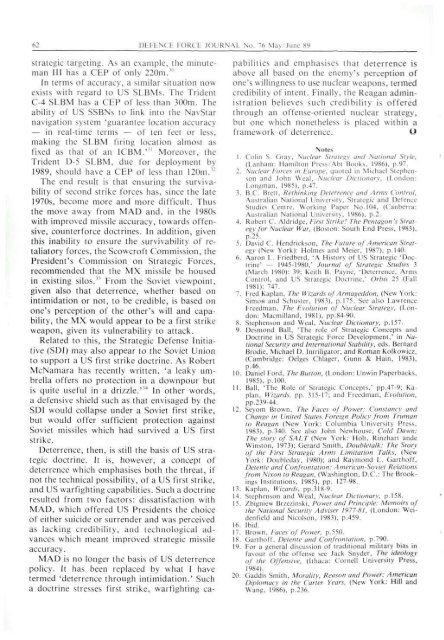ISSUE 76 : May/Jun - 1989 - Australian Defence Force Journal
ISSUE 76 : May/Jun - 1989 - Australian Defence Force Journal
ISSUE 76 : May/Jun - 1989 - Australian Defence Force Journal
- No tags were found...
You also want an ePaper? Increase the reach of your titles
YUMPU automatically turns print PDFs into web optimized ePapers that Google loves.
62 DEFENCE FORCE JOURNAL No. <strong>76</strong> <strong>May</strong>/<strong>Jun</strong>e 89strategic targeting. As an example, the minutemanIII has a CEP of only 220m.'"In terms of accuracy, a similar situation nowexists with regard to US SLBMs. The TridentC-4 SLBM has a CEP of less than 300m. Theability of US SSBNs to link into the NavStarnavigation system 'guarantee location accuracy— in real-time terms — of ten feet or less,making the SLBM firing location almost asfixed as that of an ICBM.' 11 Moreover, theTrident D-5 SLBM, due for deployment by<strong>1989</strong>, should have a CEP of less than 120m. ,:The end result is that ensuring the survivabilityof second strike forces has, since the late1970s, become more and more difficult. Thusthe move away from MAD and, in the 1980swith improved missile accuracy, towards offensive,counterforce doctrines. In addition, giventhis inability to ensure the survivability of retaliatoryforces, the Scowcroft Commission, thePresident's Commission on Strategic <strong>Force</strong>s,recommended that the MX missile be housedin existing silos." From the Soviet viewpoint,given also that deterrence, whether based onintimidation or not, to be credible, is based onone's perception of the other's will and capability,the MX would appear to be a first strikeweapon, given its vulnerability to attack.Related to this, the Strategic Defense Initiative(SDI) may also appear to the Soviet Unionto support a US first strike doctrine. As RobertMcNamara has recently written, 'a leaky umbrellaoffers no protection in a downpour butis quite useful in a drizzle.'' 4 In other words,a defensive shield such as that envisaged by theSDI would collapse under a Soviet first strike,but would offer sufficient protection againstSoviet missiles which had survived a US firststrike.Deterrence, then, is still the basis of US strategicdoctrine. It is, however, a concept ofdeterrence which emphasises both the threat, ifnot the technical possibility, of a US first strike,and US warfighting capabilities. Such a doctrineresulted from two factors: dissatisfaction withMAD, which offered US Presidents the choiceof either suicide or surrender and was perceivedas lacking credibility, and technological advanceswhich meant improved strategic missileaccuracy.MAD is no longer the basis of US deterrencepolicy. It has been replaced by what 1 havetermed 'deterrence through intimidation.' Sucha doctrine stresses first strike, warfighting capabilitiesand emphasises that deterrence isabove all based on the enemy's perception ofone's willingness to use nuclear weapons, termedcredibility of intent. Finally, the Reagan administrationbelieves such credibility is offeredthrough an offense-oriented nuclear strategy,but one which nonetheless is placed within aframework of deterrence.QNotes1. Colin S. Gray, Nuclear Strategy and National Style,(Lanham: Hamilton Press/Abt Books, 1986), p.97.2. Nuclear <strong>Force</strong>s in Europe, quoted in Michael Stephensonand John Weal, Nuclear Dictionary, (London:Longman, 1985), p.47.3. B.C. Brett, Rethinking Deterrence and Arms Control,<strong>Australian</strong> National University, Strategic and <strong>Defence</strong>Studies Centre, Working Paper No. 104, (Canberra:<strong>Australian</strong> National University, 1986), p.2.4. Robert C. Aldridge, First Strike! The Pentagon's Strategyfor Nuclear War, (Boston: South End Press, 1983),p.25.5. David C. Hendrickson, The huture oj American Strategy(New York): Holmes and Meier, 1987), p.140.6. Aaron L. Friedberd, 'A History of US Strategic 'Doctrine'— 1945-1980,' <strong>Journal</strong> of Strategic Studies 3(March 1980): 39; Keith B. Payne, 'Deterrence, ArmsControl, and US Strategic Doctrine,' Orbis 25 (Fall1981): 747.7. Fred Kaplan, The Wizards of Armageddon, (New York:Simon and Schuster, 1983), p. 175. See also LawrenceFreedman, The Evolution of Nuclear Strategy, (London:Macmilland, 1981), pp.84-90.8. Stephenson and Weal, Nuclear Dictionary, p. 157.9. Desmond Ball, 'The role of Strategic Concepts andDoctrine in US Strategic <strong>Force</strong> Development,' in NationalSecurity and International Stability, eds. BernardBrodic, Michael D. Intriligator, and Roman Kolkowicz,(Cambridge: Oelges Chlager, Gunn & Hain, 1983),p.46.10. Daniel Ford, The Button, (London: Unwin Paperbacks,1985), p.100.11. Ball, 'The Role of Strategic Concepts,' pp.47-9; Kaplan,Wizards, pp. 315-17; and Freedman, Evolution,pp.239-44.12. Seyom Brown, The Faces of Power: Constancy andChange in United Slates Foreign Policy from Trumanto Reagan (New York: Columbia University Press,1983), p.340. See also John Newhouse, Cold Dawn:The story of SALT (New York: Holt, Rinehart andeWinston, 1973); Gerard Smith, Doubletalk: The Storyof the First Strategic Arms Limitation Talks, (NewYork: Doubleday, 1980); and Raymond L. Garthoff,Detente and Confrontation: American-Soviet Relationsfrom Nixon to Reagan, (Washington, D.C.: The BrookingsInstitutions, 1985), pp. 127-98.13. Kaplan, Wizards, pp.318-9.14. Stephenson and Weal, Nuclear Dictionary, p.158.15. Zbigniew Brzezinski, Power and Principle: Memoirs ofthe National Security Adviser 1977-81, (London: Weidenfieldand Nicolson, 1983), p.459.16. Ibid.17. Brown, Faces of Power, p.550.18. Garthoff. Detente and Confrontation, p.790.19. For a general discussion of traditional military bias infavour of the offense see Jack Snyder, The ideologyof the Offensive, (Ithaca: Cornell University Press,1984).20. Gaddis Smith, Morality, Reason and Power: AmericanDiplomacy in the Carter Years, (New York: Hill andWang, 1986), p.236.
















